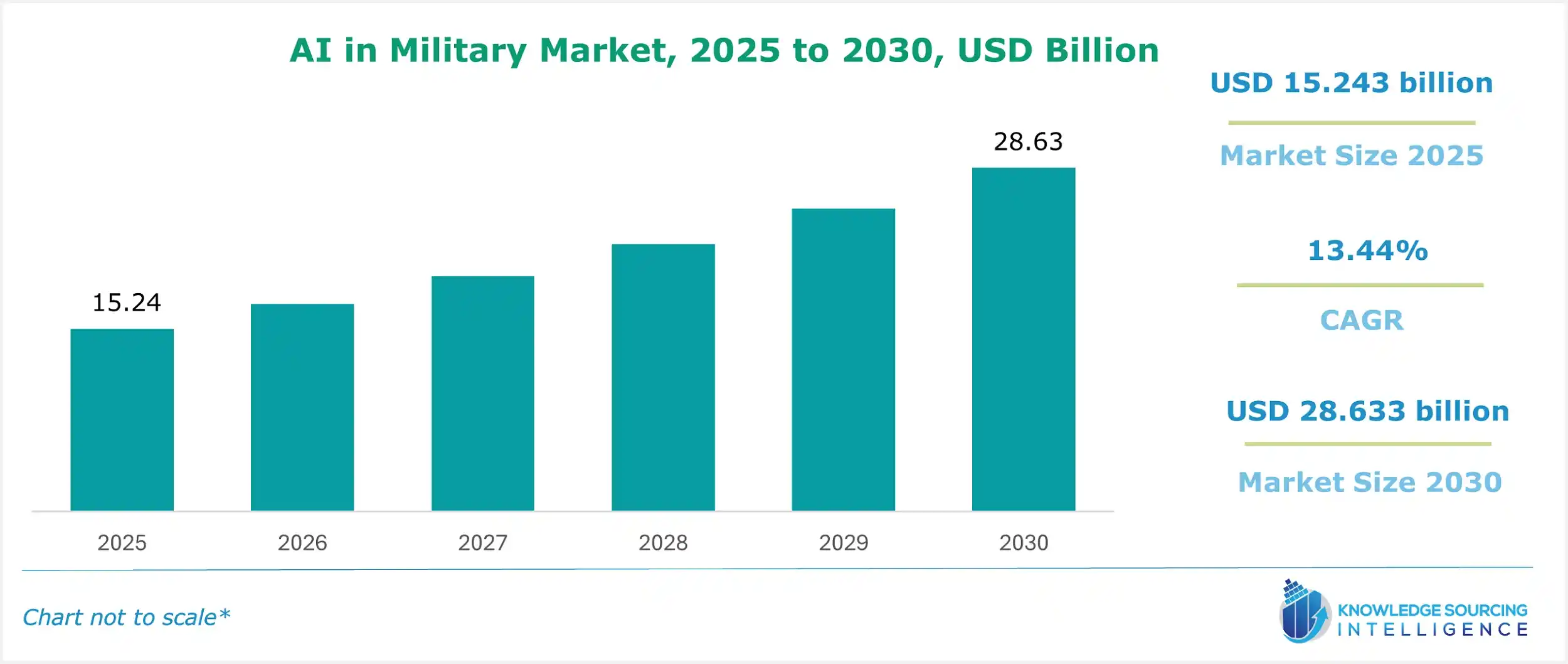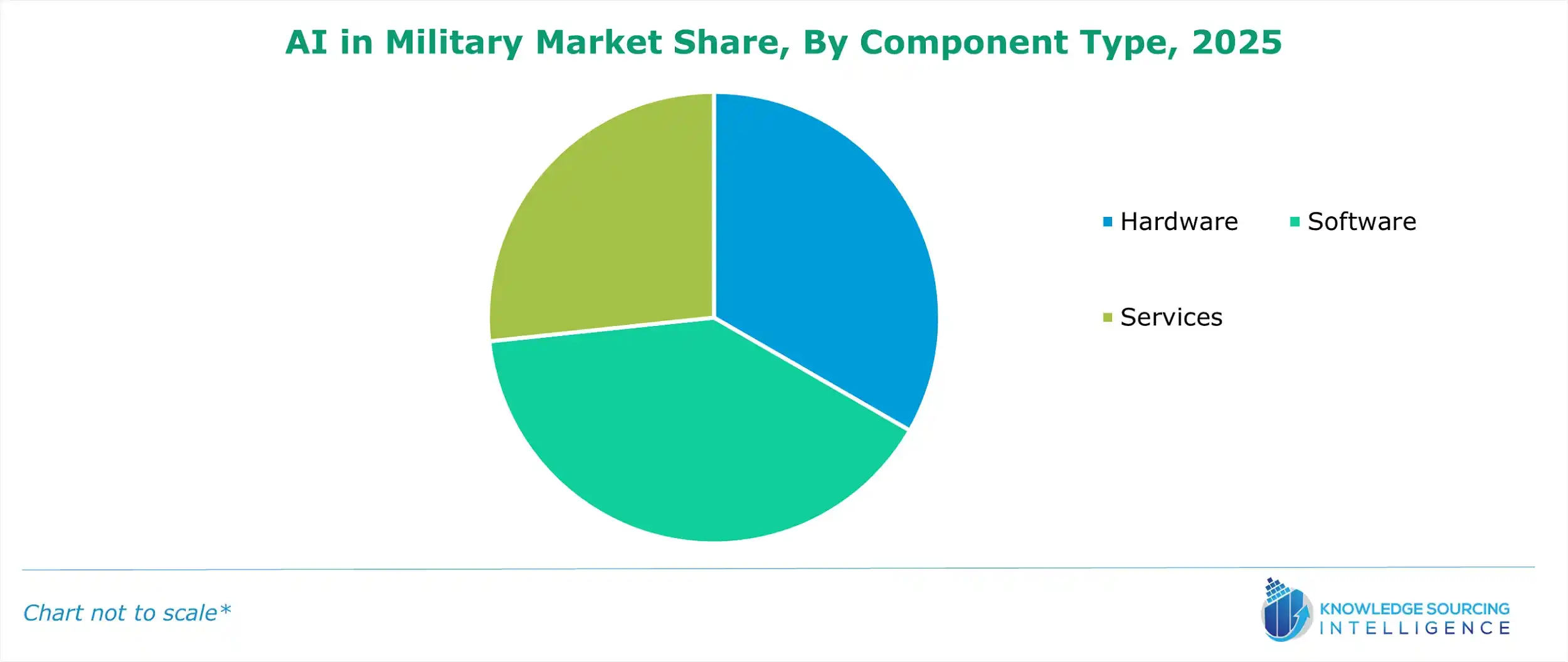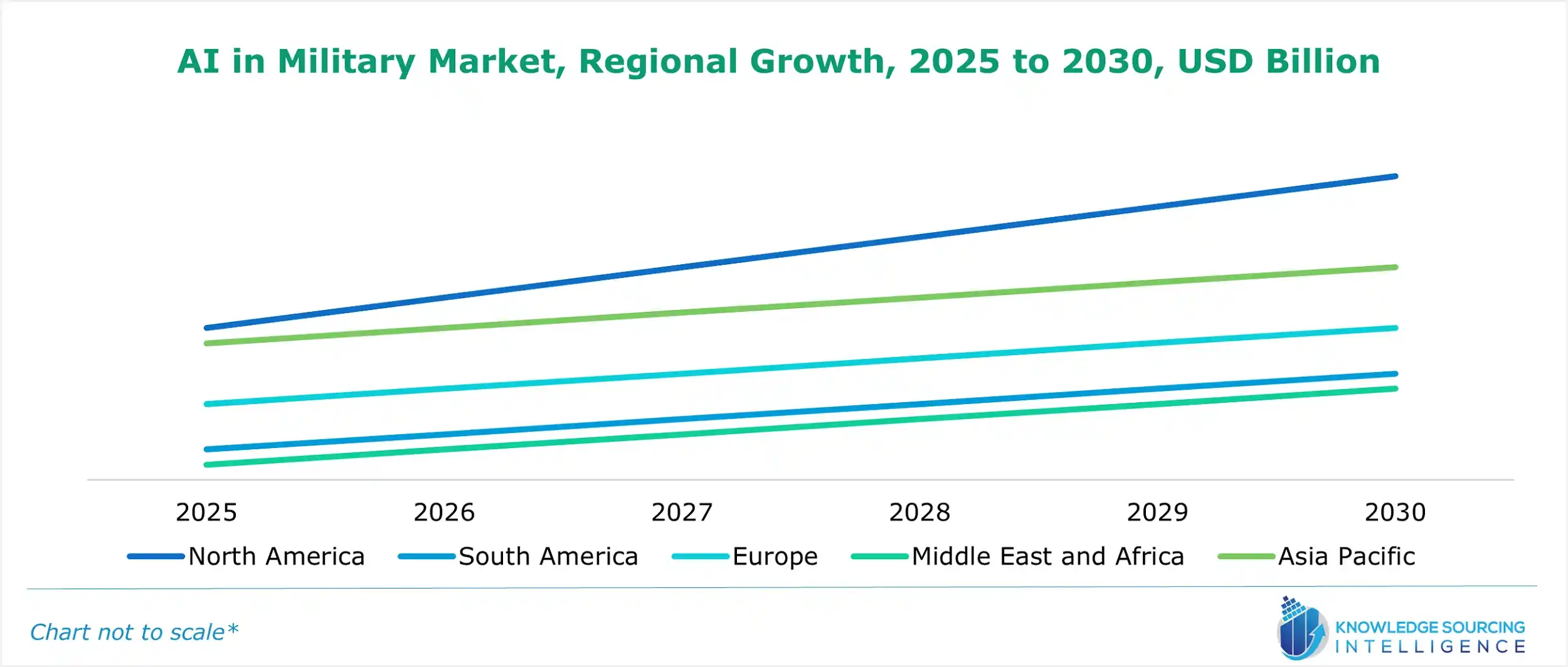AI in Military Market Size, Share, Opportunities, And Trends By Component Type (Hardware, Software, Services), By Technology (Machine Learning, Deep learning, Computer Vision, Natural Language Processing, Robotics, Others), By Application (Warfare Platforms, Cybersecurity, Logistics & Transportation, Surveillance & Reconnaissance, Command & Control, Battlefield Healthcare, Simulation & Training, Gathering Intelligence, Others), By Platform (Land-based Force, Naval Force, Air Force, Space Force), And By Geography - Forecasts From 2025 To 2030
- Published : Feb 2025
- Report Code : KSI061617308
- Pages : 143
AI in Military Market Size:
The AI in the military market is set to witness robust growth at a CAGR of 13.44% during the forecast period, reaching US$28.633 billion in 2030 from US$15.243 billion in 2025.

AI in Military Market Trends:
AI is gaining more attention in the military market because of the need for better tech and advanced military laser systems, among other equipment. AI is being utilized for diverse purposes, such as making robots and drones operate independently and fight on their own on battlefields, making them work better than traditional weapons. This will raise the demand for AI in the military sector during the projected period. However, AI can also be utilized to create cyber warfare, which threatens the military worldwide.
AI in Military Market Growth Drivers:
- Increasing Demand for Advanced Military Technologies: AI technology assists defense forces in observing targets and protecting their battlefields by using AI for searching and fighting. These systems keep cyber threats away from the core military systems that power the defense network. AI improves live intelligence data processing, which helps military forces select better targets for weapons. In December 2024, the Indian Army's AI Incubation Centre opened in Bengaluru in partnership with Bharat Electronics Limited to speed up AI tool development and deployment for the military.
- Growing Government Funding and Initiatives: The government is progressively investing significant funds in advancing the military to counteract the growing threats. These funding and programs assist the military in using AI better through money, tools, and regulations for faster adoption. The Pentagon Chief AI Officer began two programs in December 2024, the Rapid Capability Cell (RCC) and Frontier AI pilots - to assist Defense Department personnel in adopting new AI technology. Through these AI RCC projects, the organization works in integrating emerging tech while giving soldiers state-of-the-art AI systems.
AI in Military Market Segmentation Analysis by Component Type:
- Hardware: The military's demand for AI stems from updating hardware to include GPUs, which let systems handle large data sets and run sophisticated AI programs.
- Software: Advancements in machine learning and natural language processing aid designers in developing software systems that recognize targets and analyze threats, while deep learning enhances the processing of intelligence data. Secure military data needs extensive cybersecurity protection, leading to a rise in software demand.
- Services: There is a growing demand for AI services such as consulting and training to help military branches use AI technology throughout their operations effectively.
AI in Military Market Segmentation Analysis by Technology:
- Machine Learning: The military work more efficiently through machine learning because it assists in detecting future system breakdowns and monitoring battlefield data in real-time to run supply chains and secure vital information. The technology helps organizations plan equipment updates while streamlining supply networks and guarding their essential systems and information.
- Deep learning: Deep learning technology improves the tracking of images and videos by advanced autonomous systems. This gives military forces smarter information and decisions through drone and ground robotic systems.
AI in Military Market Geographical Outlook:
The AI in military market report analyzes growth factors across the following five regions:
- North America: Strong support from North American governments, private sector activities, and industry players improves tech development within defense research projects. The US military recorded $820.3 billion in funding during 2023, making up 13.3% of the federal budget. For 2024, the Department of Defense requested $842 billion for its budget.
- South America: South American nations augment defense funding to build new military equipment that protects their borders from criminal elements and terror groups.
- Europe: European nations are increasing their focus on cybersecurity and advanced vehicle control due to the rise in cyber threats and the practical use of military robots in battlefield operations.
- Middle East and Africa: AI-based intelligence systems are in growing demand across Middle Eastern and African nations because of the growing requirement for advanced systems to fight terrorism and update military tools.
- Asia-Pacific: Increased political conflict across Asia-Pacific pushes defense spending by major countries like Japan, China, and India upward, which combines with fast AI development to drive military systems development.
AI in Military Market– Competitive Landscape:
- Lockheed Martin Corporation
- Northrop Grumman Corporation
- Thales Group
- BAE Systems plc
These market players are establishing strategic alliances to accelerate the development of AI, targeting R&D investments to focus on emerging areas that align with their goals, such as autonomous systems, cyber warfare applications, and intelligence analysis.
AI in Military Market Latest Developments:
- In October 2024, BAE Systems and Aerospike collaborated to create real-time data solutions for the U.S. Army using advanced AI tools under their Mission Advantage technology partnership program to expedite future defense missions.
- In September 2024, the US Army launched Ask Sage, an industry-leading generative AI platform, for use on cARMY, its general-purpose cloud environment. Thus, the US Army became the first military from both the public and private sectors to integrate generative AI technology.
AI in Military Market Scope:
| Report Metric | Details |
| AI in Military Market Size in 2025 | US$15.243 billion |
| AI in Military Market Size in 2030 | US$28.633 billion |
| Growth Rate | CAGR of 13.44% |
| Study Period | 2020 to 2030 |
| Historical Data | 2020 to 2023 |
| Base Year | 2024 |
| Forecast Period | 2025 – 2030 |
| Forecast Unit (Value) | USD Billion |
| Segmentation |
|
| Geographical Segmentation | North America, South America, Europe, Middle East and Africa, Asia Pacific |
| List of Major Companies in the AI in Military Market |
|
| Customization Scope | Free report customization with purchase |
AI in Military Market is analyzed into the following segments:
- By Component Type
- Hardware
- Software
- Services
- By Technology
- Machine Learning
- Deep learning
- Computer Vision
- Natural Language Processing
- Robotics
- Others
- By Application
- Warfare Platforms
- Cybersecurity
- Logistics & Transportation
- Surveillance & Reconnaissance
- Command & Control
- Battlefield Healthcare
- Simulation & Training
- Gathering Intelligence
- Others
- By Platform
- Land-based Force
- Naval Force
- Air Force
- Space Force
- By Geography
- North America
- USA
- Canada
- Mexico
- South America
- Brazil
- Argentina
- Others
- Europe
- United Kingdom
- Germany
- France
- Spain
- Others
- Middle East and Africa
- Saudi Arabia
- UAE
- Others
- Asia Pacific
- China
- Japan
- India
- South Korea
- Taiwan
- Australia
- Others
- North America
Our Best-Performing Industry Reports:
- Artificial Intelligence Engineering Market
- Artificial Intelligence (AI) In Social Media Market
- Adaptive AI Market
Frequently Asked Questions (FAQs)
The AI in the military market is expected to reach a total market size of US$28.633 billion by 2030.
AI in Military Market is valued at US$15.243 billion in 2025.
The AI in the military market is expected to grow at a CAGR of 13.44% during the forecast period.
Key drivers include rising defense budgets, autonomous systems, cybersecurity needs, AI-powered surveillance, and combat analytics.
The North America region is anticipated to hold a significant share of the AI in the military market.
1. INTRODUCTION
1.1. Market Overview
1.2. Market Definition
1.3. Scope of the Study
1.4. Market Segmentation
1.5. Currency
1.6. Assumptions
1.7. Base and Forecast Years Timeline
1.8. Key benefits for the stakeholders
2. RESEARCH METHODOLOGY
2.1. Research Design
2.2. Research Process
3. EXECUTIVE SUMMARY
3.1. Key Findings
4. MARKET DYNAMICS
4.1. Market Drivers
4.2. Market Restraints
4.3. Porter’s Five Forces Analysis
4.3.1. Bargaining Power of Suppliers
4.3.2. Bargaining Power of Buyers
4.3.3. Threat of New Entrants
4.3.4. Threat of Substitutes
4.3.5. Competitive Rivalry in the Industry
4.4. Industry Value Chain Analysis
4.5. Analyst View
5. AI IN THE MILITARY MARKET BY COMPONENT TYPE
5.1. Introduction
5.2. Hardware
5.3. Software
5.4. Services
6. AI IN THE MILITARY MARKET BY TECHNOLOGY
6.1. Introduction
6.2. Machine Learning
6.3. Deep learning
6.4. Computer Vision
6.5. Natural Language Processing
6.6. Robotics
6.7. Others
7. AI IN THE MILITARY MARKET BY APPLICATION
7.1. Introduction
7.2. Warfare Platforms
7.3. Cybersecurity
7.4. Logistics & Transportation
7.5. Surveillance & Reconnaissance
7.6. Command & Control
7.7. Battlefield Healthcare
7.8. Simulation & Training
7.9. Gathering Intelligence
7.10. Others
8. AI IN THE MILITARY MARKET BY PLATFORM
8.1. Introduction
8.2. Land-based Force
8.3. Naval Force
8.4. Air Force
8.5. Space Force
9. AI IN THE MILITARY MARKET BY GEOGRAPHY
9.1. Introduction
9.2. North America
9.2.1. By Component Type
9.2.2. By Technology
9.2.3. By Application
9.2.4. By Platform
9.2.5. By Country
9.2.5.1. USA
9.2.5.2. Canada
9.2.5.3. Mexico
9.3. South America
9.3.1. By Component Type
9.3.2. By Technology
9.3.3. By Application
9.3.4. By Platform
9.3.5. By Country
9.3.5.1. Brazil
9.3.5.2. Argentina
9.3.5.3. Others
9.4. Europe
9.4.1. By Component Type
9.4.2. By Technology
9.4.3. By Application
9.4.4. By Platform
9.4.5. By Country
9.4.5.1. United Kingdom
9.4.5.2. Germany
9.4.5.3. France
9.4.5.4. Spain
9.4.5.5. Others
9.5. Middle East and Africa
9.5.1. By Component Type
9.5.2. By Technology
9.5.3. By Application
9.5.4. By Platform
9.5.5. By Country
9.5.5.1. Saudi Arabia
9.5.5.2. UAE
9.5.5.3. Others
9.6. Asia Pacific
9.6.1. By Component Type
9.6.2. By Technology
9.6.3. By Application
9.6.4. By Platform
9.6.5. By Country
9.6.5.1. China
9.6.5.2. Japan
9.6.5.3. India
9.6.5.4. South Korea
9.6.5.5. Taiwan
9.6.5.6. Others
10. COMPETITIVE ENVIRONMENT AND ANALYSIS
10.1. Major Players and Strategy Analysis
10.2. Market Share Analysis
10.3. Mergers, Acquisitions, Agreements, and Collaborations
10.4. Competitive Dashboard
11. COMPANY PROFILES
11.1. Anduril Industries
11.2. C3.ai
11.3. General Dynamics Information Technology
11.4. IBM
11.5. L3Harris Technologies
11.6. Microsoft
11.7. Palantir Technologies
11.8. QinetiQ
11.9. Rafael Advanced Defense Systems
11.10. Lockheed Martin Corporation
11.11. Northrop Grumman Corporation
11.12. BAE Systems plc
11.13. Thales Group
Anduril Industries
C3.ai
General Dynamics Information Technology
IBM
L3Harris Technologies
Microsoft
Palantir Technologies
QinetiQ
Rafael Advanced Defense Systems
Lockheed Martin Corporation
Northrop Grumman Corporation
BAE Systems plc
Thales Group
Related Reports
| Report Name | Published Month | Download Sample |
|---|---|---|
| Artificial Intelligence Processor Market Size: Forecast 2030 | Jan 2025 | |
| Swarm Intelligence Market Size & Forecast 2025-2030 | Free Sample | Dec 2024 | |
| Artificial Intelligence in Education Market, 2025-2030 | Free Sample | Feb 2025 | |
| AI in Manufacturing Market Size & Forecast 2024-2029 | Free Sample | Oct 2024 | |
| AI Solutions Market Size & Forecast 2024-2029 | Free Sample | Nov 2024 |





